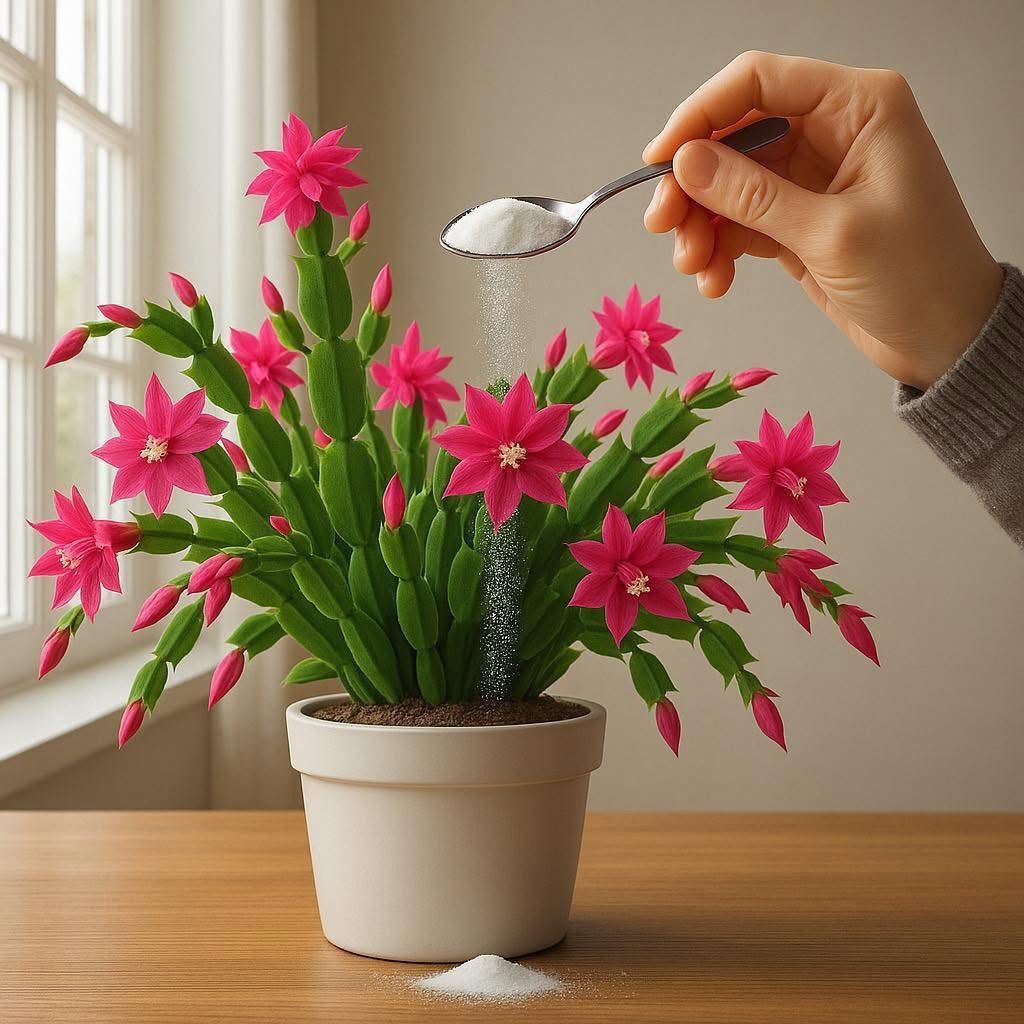Using Household Additives Like Sugar for Indoor Plants: A Look at Myths and Methods

Introduction
Indoor gardening has seen a rise in popularity as more people turn to houseplants for their calming aesthetic, air-purifying qualities, and connection to nature. Among these plants, flowering succulents and cacti, like the one in the image, are admired for their vivid blooms and low-maintenance requirements. A curious practice shown in the image — sprinkling white powder, possibly sugar — onto the plant’s soil has sparked interest. But does this actually benefit the plant, or is it a gardening myth?
This article explores the science, speculation, history, and practical considerations of adding sugar and similar substances to houseplants, especially succulents.
Ingredients & Additives Used in Gardening
Here are common additives, some natural and others synthetic, occasionally added to indoor plants:
- Sugar – Often thought to “feed” the plant.
- Epsom salt – Magnesium sulfate for greener leaves.
- Baking soda – Sometimes used to prevent fungal growth.
- Cinnamon – Used as an antifungal and root hormone.
- Hydrogen peroxide – For root rot and aeration.
- Compost or worm castings – Nutrient-rich organic fertilizers.
- Diluted coffee or tea – For acidity-loving plants.
The Science Behind Sugar and Plants
1. Photosynthesis Makes Sugar Naturally
Plants make their own sugar (glucose) through photosynthesis, using sunlight, carbon dioxide, and water. Adding sugar externally is not necessary for energy.
2. Effect on Soil Microbes
Adding sugar to soil can cause a microbial bloom, feeding beneficial or harmful bacteria. While this may improve soil life short-term, overuse can lead to root rot or attract pests.
3. Temporary Growth Spurts
In rare cases, a diluted sugar solution may cause temporary perkiness in plants under stress (like transplant shock), but it’s not a sustainable growth strategy
History of the Practice
The idea of feeding sugar to plants likely stems from:
- Folk gardening traditions, where household waste was repurposed.
- Greenhouse practices, where sugar water was sometimes used to extend flower life in cut flowers, not rooted plants.
- Misinterpretation of floristry tips, confusing vase flowers with living plants.
Potential Benefits (If Done Right)
- Stimulates microbial activity in compost-heavy soils.
- Encourages rooting in propagation when used with rooting agents.
- Aids recovery from transplanting or wilting in very diluted doses.
Risks and Drawbacks
- Fungal growth and mold
- Insects like ants or gnats
- Root rot from overwatering combined with sugar
- Nutrient imbalance
- Salt build-up in the soil
Proper Method (If You Must Try It)
- Use 1 teaspoon of sugar in 1 liter of water.
- Apply once a month at most, only if the plant seems stressed.
- Ensure good drainage and dry topsoil between watering.
- Never sprinkle dry sugar directly onto the soil like shown in the image — it attracts pests and causes soil compaction.
Nutritional Facts of Soil Additives
| Additive | Main Nutrients | Benefit |
|---|---|---|
| Sugar (sucrose) | Carbon (indirect) | Stimulates soil microbes |
| Epsom salt | Magnesium, sulfur | Greener leaves |
| Compost | NPK + trace minerals | General growth |
| Banana peel | Potassium, phosphorus | Flowering support |
Real Gardeners’ Opinions (“Lovers”)
Many plant lovers and home gardeners are divided:
Supporters Say:
- “My orchids perked up after a little sugar water.”
- “Helps seedlings get over transplant shock.”
Skeptics Say:
- “Sugar belongs in the kitchen, not my potting mix.”
- “Ants invaded my cactus pot after I tried it.”
Most experienced gardeners agree that balanced fertilizers, compost, and good care are far more effective than sugar.
Conclusion
While the idea of adding sugar or similar white powders to flowering cacti and succulents seems like an easy hack, it often leans more toward myth than miracle. Plants naturally produce their own sugars and benefit more from good sunlight, well-draining soil, and the occasional organic feeding.
If you do want to experiment, always do so in moderation and monitor your plant’s reaction closely. Nature already knows best — we just need to support it thoughtfully.